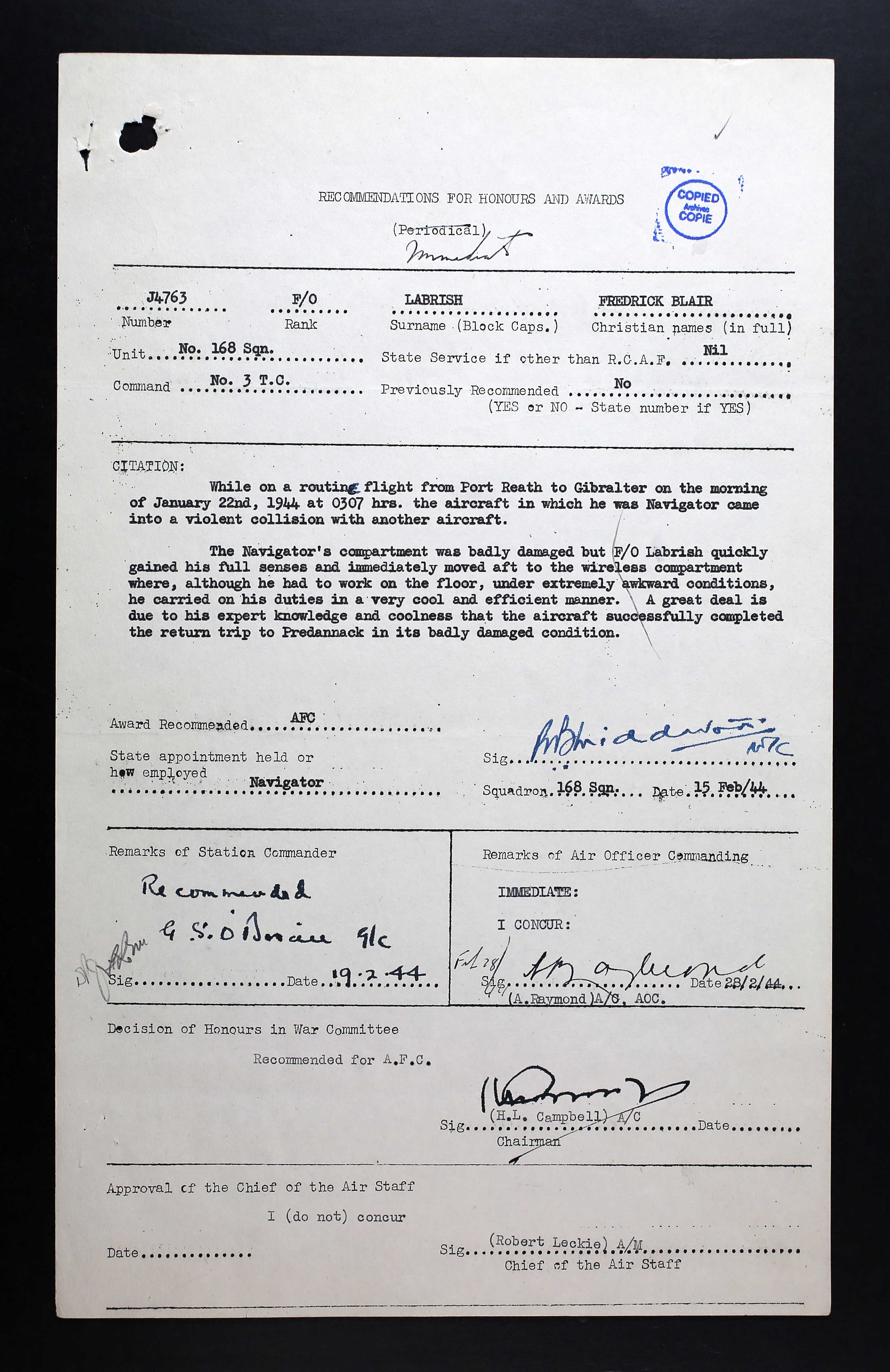

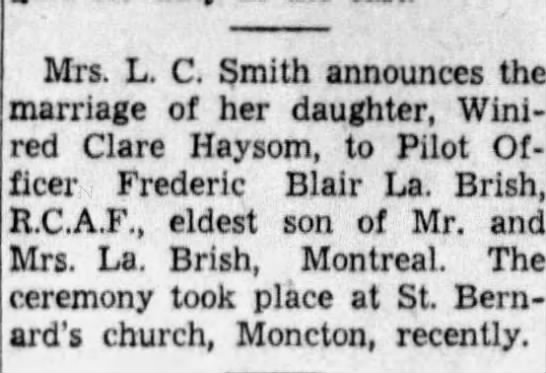
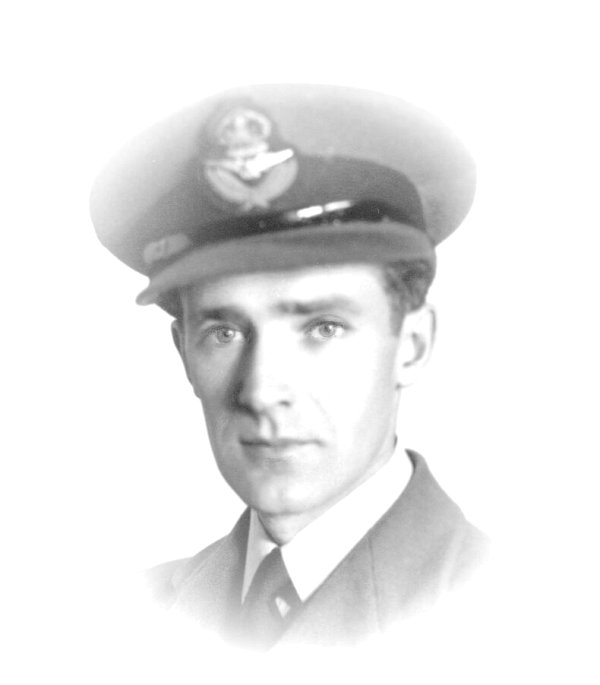
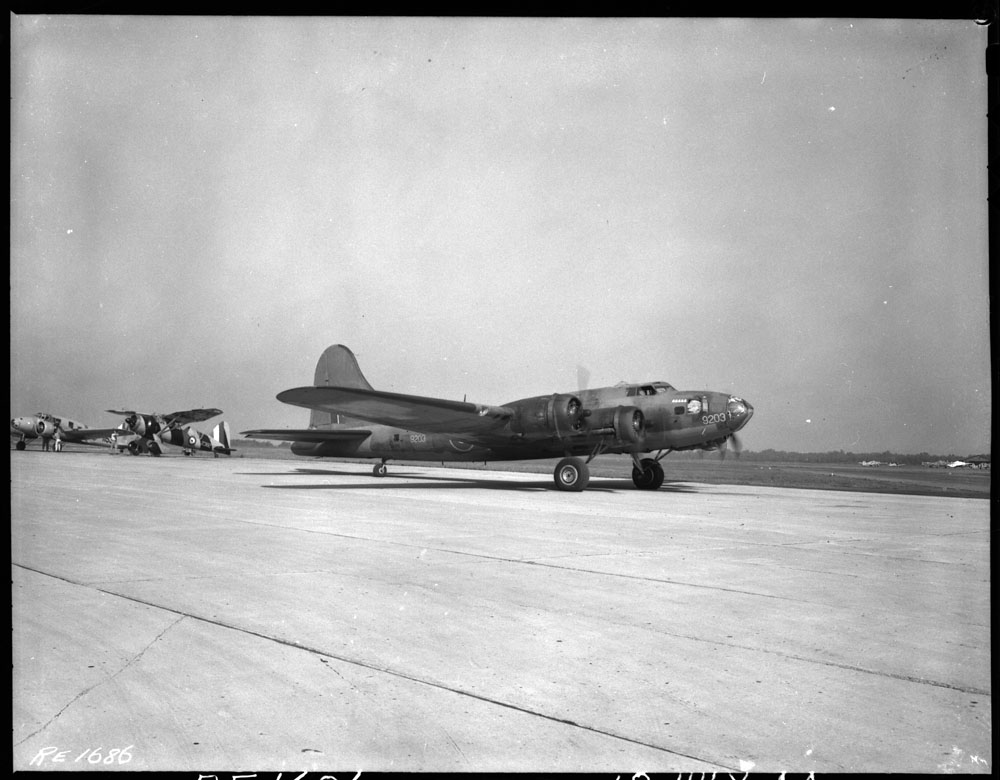
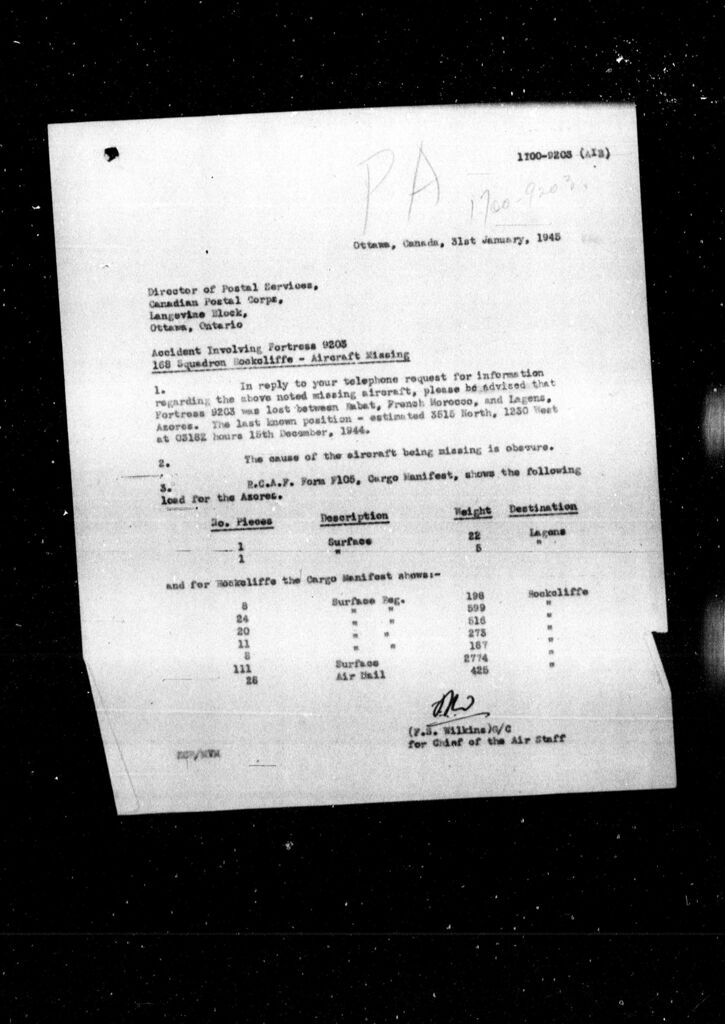

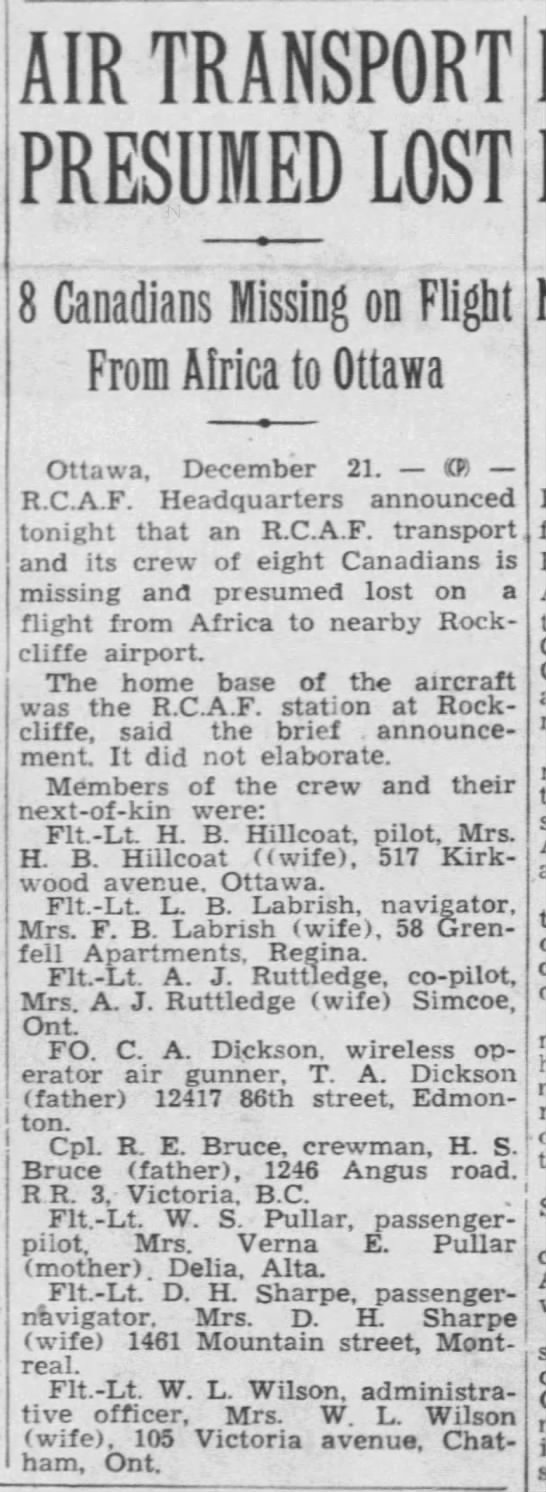
June 17, 1913 - December 15, 1944








Frederick La Brish was the son of Francis Edward La Brish (d. 1963), clerk with Sun Life Assurance Co. and Kate Manson (nee O’Hara) La Brish (d. 1954) of Montreal, Quebec. He had one brother, Gordon. The family was Presbyterian.
In May 1940, Frederick applied to enlist with the RCAF. He was an accountant with Haskell Elderkin & Co. in Montreal for just over a year. He spoke French ‘slightly.’ He liked to golf, ski, play tennis and baseball. “Very good type. Courteous. Bright, observant, intelligent.”
He indicated he had occasional nervous indigestion. He was sixteen pounds underweight, but his weight was consistent for the past five years. he stood 5’7” tall and weighed 125 pounds. He had blue eyes and blond hair. His teeth were considered healthy, with a few fillings.
At No. 2 ITS, September 1 - 30, 1940: 77%, 15th out of 535 in class. Good background and splendid type.”
He was sent to No. 3 AOS, October 14, 1940 to January 6, 1941: “Has been consistently good in the air. A quick worker. GROUND TRAINING: Above average intelligence. Has had good results but could have done better.” He was ranked above average as navigator and observer. “Good personality. Has ability.” He was 4th out of 40 in his class. He was at the station hospital from January 1-2, 1941.
From January 6 to February 17, 1941, he was at No. 2 BGS: “Considered satisfactory in view of the following inexperience pilots, uncalibrated instruments, targets difficult to see, restriction of bomb-aimers’ forward vision on Fairey Battle aircraft.” He was 15th out of 40 in his class. “This man was under consideration as an instructor, but it is the opinion of the staff of this school that he is not suitable to serve in that capacity. It will be noted that his results for practical B&G were only average.” Here he earned his Air Observer’s Badge.
Frederick was sent to No. 1 ANS, February 17 to March 15, 1941: “Very good air navigator. Excellent student in ground training. 17th out of 82 in class. Above average. Accurate and swift. Thorough grasp of all astronomical subjects.” His final assessment: “pleasant, neat and forceful.”
In April 1941, Frederick married Winifred Clare Haysom (1915-1960) in Truro, Nova Scotia; she later resided in Regina, Saskatchewan. They had a daughter, Lucy-Clare, born in October 1941. Winifred never remarried.
Frederick was posted overseas shortly afterwards.
He was repatriated March 1942 and taken on at No. 1 CNS Rivers, then sent to No. 9 AOS St. John’s, Quebec, then to No, 1 O.T.U. Bagotville. He was also at No. 3 TC, HQS, No. 1 AOS, Chatham and then posted to Rockcliffe with 168 Squadron.
A letter written by Frederick dated July 20, 1942: “I have the honour to request that I be released from my attachment to the RAF and that I be re-attached to the RCAF. In as much as I have completed 28 operational flights amounting to over two hundred and fifty hours on Wellington aircraft from England, Egypt and Malta and have a total of over five hundred- and fifty-hours flying time, I would request that I be granted a pilot’s course. I am now a specialist navigator.”
In September 1942, a letter was written about Fred’s request. “These officers have completed an operational tour and were placed on ferrying duties for a rest…these officers ceased to be attached to the RAF and are posted from the RAF Ferry Command, Dorval, to the Repatriation Pool, RCAF Station, Rockcliffe, effective June 27, 1942 reporting September 14, 1942. Arrangements are being made to post these personnel from the Repatriation Pool to Air Observers Schools at the earliest possible date.”
Fred reported to No. 1 ANS, Rivers, Manitoba, course 16AO1. “A good voice and manner and a competent lecturer when on a subject he knows well. Weak on subjects which have not been used on the type of operations he was on.”
It was noted on his confidential report: “A qualified Air Observer with operational experience. This Officer is well qualified but not particularly interested in instructing. He is very anxious to take a pilot’s course but has not been recommended as yet. He has ability, but domestic troubles may have some bearing on his disinterested attitude at times.” March 24, 1943.
“A qualified Air Navigator with operational experience in Near East. This officer has good instructional ability but would much rather return to operational duties than continue instructing.” June 18, 1943, No. 9 AOS, St. John’s, Quebec.
On May 13, 1943, while at St. John’s, Quebec, Frederick was under arrest and was charged with drunkenness on May 17th. It was found that he was guilty of using abusive and derogatory language to his superior officer and was reprimanded.
On June 24, 1943, a letter was written about F/O La Brish. “The subject officer was recently posted to this Unit as a replacement for our Navigation Officer, J4425 F/L B. S. Imrie, who is proceeding overseas. On arrival F/O La Brish was interviewed by the Chief Instructor and the undersigned, and it was found that although he appeared keen and well qualified, he was not a qualified pilot, which is an essential qualification for the Navigation Instructor at this O.T.U. All navigation trips are done in Harvard aircraft and consist of four legs -- two under the hood, one with a skeleton map and the other with a clear hood. The Navigation Officer must, therefore, be a qualified pilot to check each student individually in Fighter Navigation. In view of the urgency for an immediate replacement, the subject matter of this letter was telephoned to EAC recently and it was learned that action was being instituted with AFHQ. Apart from the fact that F/O La Brish is not a qualified pilot, his confidential file which arrived a few days before him does not make good reading. The latest entry on his file shows that he was awarded a reprimand by the Air Officer commanding, No. 3 Training Command, approximately two weeks ago….with this entry alone, it is not understood why F/O La Brish was posted here in any case since the establishment calls for the rank of F/L for which the subject officer obviously cannot be considered for some considerable time….it is recommended that F/O La Brish be returned to active operations Overseas for which he expresses a very strong desire.”
September 8, 1943: Fred was employed on instructional duties at No. 10 AOS, Chatham. “F/O La Brish appears to be quite unsuited for instructional duties and has frequently requested that he be posted back to operations. His service attitude, however, is quite good, but in view of his temperamental unsuitability for the work assigned to him, his presence at No. 10 AOS or any other training unit is not considered desirable. It is requested that this officer be posted to duties in the Home War Establishment in Eastern or Western Air Command.”
On March 1, 1944: “This man is not an apple-polisher, and may make a poor showing in matters in which he has no real interest or faith. He is popular with his fellow officers. Is an exceptionally able navigator. On two recent occasions, his skill and coolness were major factors in saving crew and aircraft in a dangerous situation. His immediate promotion to F/L is strongly recommended.” One situation: “While on a routing flight from Port Reath to Gibraltar on the morning of January 22, 1944 at 0307 hrs, the aircraft in which he was navigator came into a violent collision with another aircraft. The Navigator’s compartment was badly damaged but F/O La Brish quickly gained his full senses and immediately moved aft to the wireless compartment where, although he had to work on the floor under extremely awkward conditions, he carried on his duties in a very cool and efficient manner. A great deal is due to his expert knowledge and coolness that the aircraft successfully completed the return trip to Predannack in its very badly damaged condition.”
Effective May 5, 1944, Frederick was awarded the Air Force Cross.
On July 28, 1944, he was at the station hospital.
The crew and passengers aboard Fortress 9203 were on a transatlantic flight from French Morocco to Canada via the Azores. They went missing on December 15, 1944. A few mailbags were spotted floating on the surface during the search.
CREW: • F/L Horace Brougham ‘Pat’ Hillcoat, Pilot, Ottawa, Ontario • F/L Frederick Blair La Brish, Navigator, Regina, Saskatchewan • F/L Alfred John De Laune. Ruttledge, Co-pilot, Simcoe, Ontario • F/O Cecil Alexander. Dickson, WO, Edmonton, Alberta • Cpl. Robert Emerson Bruce, crewman, Victoria, BC • F/L William Stewart Pullar, passenger-Pilot, Delia, Alberta • F/L Douglas Haig Sharpe, passenger-Navigator, Montreal, Quebec, • F/L William Laurel Wilson, administrative officer, Chatham, Ontario
(See Dave O’Malley’s article. for additional information and photos.)
July 9, 1945: “The situation is that the RAF look upon this as an operational flight, concerning which they usually take no action beyond a circumstantial report. No. 9 Group can produce witnesses’ statement showing that the personnel concerned were actually in the aircraft when it left Rabat, that no other call was made enroute and that nothing further is known of the aircraft since its disappearance.”
On September 26, 1945, Winifred and Fred’s parents received a telegram informing them: “PREVIOUSLY REPORTED MISSING 15-DEC-44 AFTER AIR OPERATIOINS (FLYING OVERSEAS MAIL) LOST BETWEEN RABAT FRENCH MOROCCO AND LAGENS, AZORES. LAST KNOWN POSITION ESTMATED AT 2615 NORTH 1230 WEST.. NOW PRESUMED DEAD 15-DEC-44 FOR OFFICIAL PURPOSES.”
In late October, 1955, Winifred received a letter informing her that since Fred had no known grave, his name would appear on the Ottawa Memorial.
LINKS: